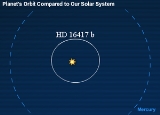
HD 16417 b
Encyclopedia
HD 16417 b is an extrasolar planet
located approximately 83 light years away in the constellation
of Fornax
, orbiting the 6th magnitude
G-type main sequence
star
λ2 Fornacis
. This planet has minimum mass
only 7% that of Jupiter
, making this a Neptune
-mass planet. In addition to this, it orbits relatively close to the host star and suffers high temperature. It is the third planet discovered in Fornax constellation on February 23, 2009. This planet was discovered by a method called the radial velocity method.
Extrasolar planet
An extrasolar planet, or exoplanet, is a planet outside the Solar System. A total of such planets have been identified as of . It is now known that a substantial fraction of stars have planets, including perhaps half of all Sun-like stars...
located approximately 83 light years away in the constellation
Constellation
In modern astronomy, a constellation is an internationally defined area of the celestial sphere. These areas are grouped around asterisms, patterns formed by prominent stars within apparent proximity to one another on Earth's night sky....
of Fornax
Fornax
Fornax is a constellation in the southern sky. Its name is Latin for furnace. It was created in the 18th century and is now one of the 88 modern constellations.-History:Fornax was formed by Nicolas Louis de Lacaille in 1756...
, orbiting the 6th magnitude
Apparent magnitude
The apparent magnitude of a celestial body is a measure of its brightness as seen by an observer on Earth, adjusted to the value it would have in the absence of the atmosphere...
G-type main sequence
Main sequence
The main sequence is a continuous and distinctive band of stars that appears on plots of stellar color versus brightness. These color-magnitude plots are known as Hertzsprung–Russell diagrams after their co-developers, Ejnar Hertzsprung and Henry Norris Russell...
star
Star
A star is a massive, luminous sphere of plasma held together by gravity. At the end of its lifetime, a star can also contain a proportion of degenerate matter. The nearest star to Earth is the Sun, which is the source of most of the energy on Earth...
λ2 Fornacis
Lambda2 Fornacis
Lambda² Fornacis is a 6th magnitude G-type main sequence star located approximately 83 light years away in the constellation of Fornax...
. This planet has minimum mass
Minimum mass
In astronomy, minimum mass is the lower-bound calculated mass of observed objects such as planets, stars and binary systems, nebulae, and black holes. Minimum mass is a widely cited statistic for extrasolar planets...
only 7% that of Jupiter
Jupiter
Jupiter is the fifth planet from the Sun and the largest planet within the Solar System. It is a gas giant with mass one-thousandth that of the Sun but is two and a half times the mass of all the other planets in our Solar System combined. Jupiter is classified as a gas giant along with Saturn,...
, making this a Neptune
Neptune
Neptune is the eighth and farthest planet from the Sun in the Solar System. Named for the Roman god of the sea, it is the fourth-largest planet by diameter and the third largest by mass. Neptune is 17 times the mass of Earth and is slightly more massive than its near-twin Uranus, which is 15 times...
-mass planet. In addition to this, it orbits relatively close to the host star and suffers high temperature. It is the third planet discovered in Fornax constellation on February 23, 2009. This planet was discovered by a method called the radial velocity method.

